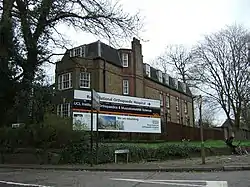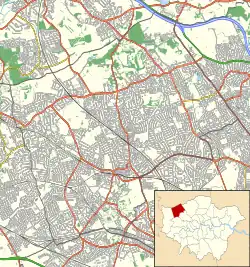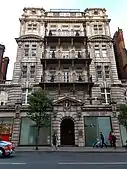| Royal National Orthopaedic Hospital | |
|---|---|
| Royal National Orthopaedic Hospital NHS Trust | |
 The hospital's main site in Stanmore | |
 Shown in Harrow | |
| Geography | |
| Location | Brockley Hill, Stanmore HA7 4LP, London Borough of Harrow, United Kingdom |
| Organisation | |
| Care system | NHS England |
| Type | Specialist |
| Affiliated university | University College London |
| Services | |
| Emergency department | No Accident & Emergency |
| Beds | 220 |
| Speciality | Orthopaedic surgery |
| History | |
| Opened | August 1905 |
| Links | |
| Website | www |
| Lists | Hospitals in the United Kingdom |
The Royal National Orthopaedic Hospital (RNOH) is a specialist orthopaedic hospital located in the London Borough of Harrow, United Kingdom, and a part of Royal National Orthopaedic Hospital NHS Trust. It provides the most comprehensive range of neuro-musculoskeletal health care in the UK, including acute spinal injury, complex bone tumour treatment, orthopaedic medicine and specialist rehabilitation for chronic back pain.[1] The RNOH is a major teaching centre and around 20% of orthopaedic surgeons in the UK receive training there.[1]
History
The hospital was established by way of a merger of the Royal Orthopaedic Hospital (founded in 1840 and based in Hanover Square) and the National Orthopaedic Hospital (founded in 1836 and based in Great Portland Street) in August 1905.[2] The City Orthopaedic Hospital (founded in 1851 and based in Hatton Garden) joined the merger in 1907.[2]
New facilities for the merged entities were built on Great Portland Street and were opened by King Edward VII in July 1909.[2] During the First World War, the hospital in Great Portland Street became an emergency hospital for the military and from early 1918 also accommodated discharged disabled soldiers.[2] The Great Portland Street site continued to accommodate short-term in-patients after the war.[2]
In 1922, the hospital management acquired the Mary Wardell Convalescent Home for Scarlet Fever in Stanmore and established its country branch there.[3] The Duke of Gloucester laid the foundation stone for a major extension at the Stanmore site shortly thereafter.[3] The Stanmore site started to accommodate long-term in-patients at this time.[3] In April 1979, the Prince of Wales opened a Rehabilitation Assessment Unit at the Stanmore site, built with funds raised by the British Motor Racing Drivers Association in memory of Graham Hill who had once been a patient of the hospital.[3] In March 1984, the Princess of Wales opened a spinal injuries unit at the Stanmore site.[3] Later that year, the lease on the building in Great Portland Street ended and services were transferred to the Stanmore site.[2]
The Royal National Orthopaedic Hospital has had a central London out-patients clinic on Bolsover Street since 1909; the old facility closed in 2006 and a completely re-built facility opened on Bolsover Street in 2009.[4]
In 2016, Norman Sharp, a 91-year-old British man, was recognised as having the world's oldest hip replacement implants. The two vitallium implants had been implanted at the Royal National Orthopaedic Hospital in November 1948. The 67-year-old implants had such an unusually long life, partly because they had not required the typical replacement of such implants, but also because of Mr Sharp's young age of 23 when they were implanted, owing to a childhood case of septic arthritis.[5]
Services
As a national centre of excellence, the RNOH treats patients from across the country, many of whom have been referred by other hospital consultants for second opinions or for treatment of complex or rare conditions.[6]
It broadcasts a hospital radio called Radio Brockley.[7]
Performance
It was named by the Health Service Journal as one of the top hundred NHS trusts to work for in 2015. At that time, it had 1310 full-time equivalent staff and a sickness absence rate of 2.88%. 87% of staff recommend it as a place for treatment and 71% recommended it as a place to work.[8]
It expects to lose £15.2m in income, 11% of its turnover during 2016–17 under changes to the NHS tariff, more than a 25% of what it received last year for inpatient work.[9] In 2014, the Care Quality Commission recorded the Hospital as requiring improvement.[10]
Notable staff
- Sir Herbert Seddon (1903–1977), orthopaedic surgeon and author of Surgical Disorders of the Peripheral Nerves
- Audrey Smith (1915–1981), cryobiologist
- David Trevor (1905–1987), Orthopaedic Surgeon[11]
- John Cholmeley (1902–1995), Orthopaedic Surgeon[12]
- James Noel Chalmers Barclay (Ginger) Wilson (1919–2006), Orthopaedic Surgeon[13]
- Rainer Campbell-Connolly (1919–2009), Neuro-Surgeon[14]
- Mary Elizabeth Pinsent, Royal Red Cross (1868-1960), Assistant Matron / Acting Matron 1904-1906,[15] Matron 1906[16]-1933.[17] She had leave of absence 1914-1919 and served as matron in the Territorial Force Nursing Service and Queen Alexandra's Imperial Military Nursing Service (Reserve).[18] Pinsent trained at The London Hospital under Matron Eva Luckes.[19][20][21][22][15]
- Professor Tim Briggs, Orthopaedic Surgeon, Creator of the Getting It Right First Time (GIRFT) initiative and National Director for Clinical Improvement and Elective Recovery[23]
See also
References
- 1 2 "Britain's best hospitals: A patients' guide". The Independent. 20 March 2008. Retrieved 3 June 2011.
- 1 2 3 4 5 6 "Royal National Orthopaedic Hospital: Great Portland Street Branch". Lost Hospitals of London. Retrieved 30 June 2018.
- 1 2 3 4 5 "Royal National Orthopaedic Hospital: Stanmore Branch". Lost Hospitals of London. Retrieved 30 June 2018.
- ↑ "Royal National Orthopaedic Hospital: Bolsover Street Branch". Lost Hospitals of London. Retrieved 30 June 2018.
- ↑ "Former RNOH patient has world's oldest hip replacements". Royal National Orthopaedic Hospital. 21 March 2016.
- ↑ "Royal National Orthopaedic Hospital". Care Quality Commission. Retrieved 30 June 2018.
- ↑ "Radio Brockley". Retrieved 30 December 2020.
- ↑ "HSJ reveals the best places to work in 2015". Health Service Journal. 7 July 2015. Retrieved 23 September 2015.
- ↑ "NHS orthopaedic hospitals warn of funding crisis due to payment changes". The Guardian. 29 October 2015. Retrieved 30 October 2015.
- ↑ "Royal National Orthopaedic Hospital NHS Trust". www.cqc.org.uk. Retrieved 16 November 2018.
- ↑ " Trevor, David (1905–1987)
- ↑ Cholmeley, John Adye (1902 - 1995)
- ↑ Wilson, James Noël Chalmers Barclay (1919 - 2006)
- ↑ Connolly, Rainer Campbell (1919 - 2009)
- 1 2 "'Miss Hole and her Successor'". The Nursing Times. 2: 282. 2 April 1906.
- ↑ "'Appointments'". The British Journal of Nursing. 37: 218. 17 March 1906 – via RCN Archive.
- ↑ Twenty-eighth Annual Report, 28 April 1933; The Royal National Orthopaedic Hospital Annual Reports; H08/A/38/006, 1933, 11; London Metropolitan Archives, London
- ↑ Mary E. Pinsent, British Army Nurses’ Service Records 1914–1918; WO399/6666; The National Archives, Kew
- ↑ Rogers, Sarah (2022). 'A Maker of Matrons’? A study of Eva Lückes’s influence on a generation of nurse leaders:1880–1919' (Unpublished PhD thesis, University of Huddersfield, April 2022)
- ↑ Sarah Rogers, ‘Mary Eliza Pinsent "May" (1868–1960): Nursing History No.18’ (SchoolsofNursing.co.uk, Collecting Nursing History, 2013) [Available at: http://www.schoolsofnursing.co.uk/Collections1/Collections19.htm , accessed on 15 March 2022]
- ↑ Mary Eliza Pinsent, Register of Probationers; RLHLH/N/1/5, 128; Barts Health NHS Trust Archives and Museums, London.
- ↑ Mary Eliza Pinsent, Register of Sisters and Nurses; RLHLH/N/4/1, 201; Barts Health NHS Trust Archives and Museums, London.
- ↑ "RNOH Stanmore Rotation – Orthopaedic Training". Stanmorerotation.co.uk. Retrieved 19 September 2022.

_old_structure_-_demolished_2010_-_panoramio.jpg.webp)
.jpg.webp)